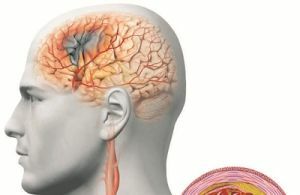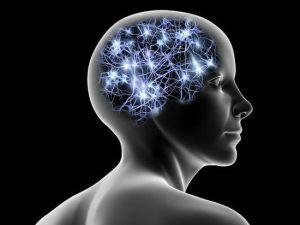
It should be noted that vascular genesis is not a separate, independent disease, but an indication of all vascular diseases of the brain.
So vascular genesis of the brain implies any pathology, a change associated with a violation of blood flow in the vascular and venous grid of the head.
Contents of
- What does genesis involve?
- Causes of disorder
- Objective and subjective sensations
- What is needed to diagnose
- General approach to therapy
- Danger of this condition
- Relapse prevention
What does genesis involve?
Focal or organic lesions of the brain substance of vascular origin occur in the following cases:
- Transistor failure in the cerebral circulation of the brain( TIA) - in this case a focal brain lesion occurs or the entire brain suffers. In the latter case, the patient is worried about constant headaches with nausea and vomiting, but with focal damage - the patient for some time lost motor functions, the sensitivity of individual parts of the body, organs falls. This violation is reversible and is perfectly treatable.

- Blockage of arteries( cerebral atherosclerosis) - in the case of constriction of the vascular bed, this leads to a deterioration in brain nutrition and this does not have the best effect on the patient's entire condition. In this case, the disease can lead to ischemic changes in the brain - treatment involves even surgery, surgeons intervention.
- Brain aneurysm , in the event that it bursts and cerebral hemorrhage develops - the hemorrhagic form of genesis develops.
- Ischemic stroke , as an independent phenomenon - an organic disease of the brain of vascular genesis.
Causes of violation of
With respect to the existing factors that provoke the development of vascular disorders in the brain area, it can include the presence of such diseases as hypertension and high blood glucose level, failure in lipid metabolism, stress and bad habits - alcohol dependence and smoking,addiction, head trauma.
If we talk about the etiological factors that provoke a malfunction in the bloodstream of the brain, then the doctors include:
- hypertension and hypotension;
- diseases that affect blood;
- vasculitis and aneurysm of the cerebral vasculature;
- heart problems, accompanied by a malfunction in its rhythm;
- heart muscle defects;
- development of diabetes mellitus;
- vegetative-vascular dystonia;
- osteochondrosis, affecting the cervical spine.
The presented list of diseases that provoke the development of cerebral vascular genesis is not exhaustive - these are the most common provoking factors most commonly encountered in medical practice.
Objective and subjective sensations
Symptoms that are characteristic of this group of diseases: 
- constant or periodic increase in pressure - this can trigger pathological changes in the vascular network not only of the brain but also of the whole organism;
- the patient has an unreasonably fast pulse or vice versa - it decreases;
- attacks of headache and dizziness, increased intracranial pressure;
- rapid fatigue, the patient is unable to concentrate on a particular task;
- fits of weakness in the arms and legs, reducing their sensitivity, numbness.
What you need in order to diagnose
In order to make an accurate diagnosis for suspected vascular disease of the brain, doctors prescribe to the patient the passage of such studies as MRI and ultrasound, as well as a complex of neurological examination.
In order to determine the symptoms of the disease, doctors are assigned to conduct studies of electromagnetic activity in certain areas of the brain - this includes conducting dopplerography and applying radionuclides and spectroscopy.
But the only study that is conducted in any case is MRI, which allows to show accurate and complete information about the pathology. The principle of MRI is based on transmission from all organs and systems of echoes.
An excellent means of obtaining information on the state of cerebral vessels in diagnosing vascular genesis is by magnetic resonance angiography. This survey method allows to diagnose the presence of structural  changes in the gray matter, to analyze all the physical and chemical processes that occur in the brain.
changes in the gray matter, to analyze all the physical and chemical processes that occur in the brain.
No less common method of research and formulation of an accurate diagnosis is the use of electroencephalography - in this case, doctors remove and record fluctuations in electrical potentials that occur in the brain.
A CT scan involves scanning the brain with an X-ray - in this case, doctors take indications of how quickly x-rays penetrate the brain tissue. It is with his help that it is possible to establish both congenital and acquired problems with the cerebral vasculature.
General approach to therapy
After the patient has been confirmed with a preliminary diagnosis of cerebral vascular genesis, doctors are prescribed appropriate treatment.
The therapeutic course itself provides therapeutic measures that minimize all negative symptoms of increased intracranial pressure, atherosclerosis, stroke and other disorders.
In addition, the patient will need to normalize the lipid metabolism - this is achieved by normalizing the diet and taking certain medications. Most often, doctors prescribe medications that normalize blood flow and intracranial pressure - it can be Ergothamine, sumatriptan.
In the case of diagnosing vegetovascular dystonia, xanthine group preparations are prescribed, with the cropped nature of the head

. Brain cell regeneration at all costs is the main task of
pains-antispasmodics such as Papaverin, No-shpa.
Also, the treatment course provides for surgery - it's about removing atherosclerotic plaques that clog the blood vessels, worsening the normal blood flow. In this case, the doctors carry out the removal of part of the vessel, plugged with plaques.
After surgical intervention, the patient undergoes rehabilitation - her complex components are physiotherapeutic procedures and exercise therapy.
In general, the general treatment scheme will look like this:
- Adjusting the general regime of the day is a calm situation, no stress and physical strain, and in case of diagnosing a transistor ischemic attack, the patient is shown to adhere strictly to bed rest until the elimination of bouts of vomiting,nausea and dizziness.
- Revision of the general scheme of nutrition, menu - most of the pathologies with the vessels arise due to consumption of fatty and fried. So the patient is prescribed food according to a certain dietary menu.
- The medical course of therapy - its doctors prescribe taking into account the general nature of damage to the vessels of the brain and the location of the lesion. If the patient has a venous outflow, this will be the administration of xanthine group medicines, and if the arteriogipotonic variant of the pathology pathway is prescribed, sumatriptan, Ergotamine, with additional prescriptions of antispasmodics.
- Operative intervention of surgeons - in this case, physicians perform removal of atherosclerotic plaques or parts of the affected vessel.
Danger of this condition
When talking about the consequences that this disease can cause, then in the absence of proper and timely treatment, the patient may experience the following complications:
- rupture in the vessel and as a consequence - blood flow to the gray matter of the brain , as a result, hemorrhagic or ischemic stroke may develop;
- clogging of the thrombi of the arteries and the aorta, vessels - this reduces the supply to the brain of oxygen, nutrients, or leads to a complete cessation of supply to the brain and its death;
- changes in the transport of blood to the brain of - this can be both focal and total brain damage, leading to its complete dying or its individual parts.
Relapse prevention of
 After a patient undergoes a course of drug treatment or after a surgical procedure, he should observe a certain set of rehabilitation and restorative measures, which together will contribute to a speedy recovery, normalization of the vascular system and the work of the brain.
After a patient undergoes a course of drug treatment or after a surgical procedure, he should observe a certain set of rehabilitation and restorative measures, which together will contribute to a speedy recovery, normalization of the vascular system and the work of the brain.
So to the basic procedures, which are most often prescribed by the doctor for the rehabilitation of the patient, include physiotherapy procedures, a complex of therapeutic exercises, therapeutic gymnastics and physical education are conducted.
The doctor also selects individually effective methods for controlling excess weight and malfunction in metabolic processes, which provoke the formation of blood clots and plaques in the vessels, and also prescribes medications to restore the work of the heart and the vascular network, the brain.
It is equally important for the patient and compliance with a certain regime of the day - minimum stress and physical exertion, emotional overstrain, in case of diagnosing transient disorders - bed rest is mandatory before negative symptomatology disappears in the form of nausea, vomiting and dizziness.

